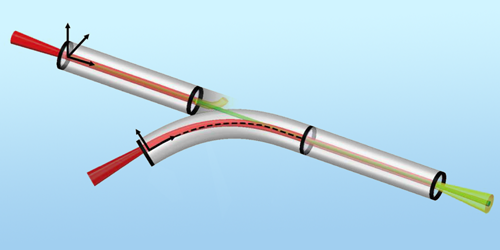Curved-Laser Demonstration for a Higher-Energy Laser Accelerator
Laser wakefield accelerators (LWFAs) use laser-generated plasmas to accelerate electrons to high energies. The devices are significantly smaller than radio-frequency-based particle accelerators—centimeters versus hundreds of meters—making them less expensive, more efficient alternatives. But researchers still need to demonstrate that LWFAs can achieve particle energies that match those of their conventional counterparts. Now Xinzhe Zhu from Shanghai Jiao Tong University and colleagues have brought that goal a step closer, demonstrating a method for linking multiple LWFAs in a way that would boost their acceleration potential [1].
In an LWFA, charged particles reach relativistic speeds by surfing a wave of plasma created by a powerful laser. The particle energy achievable with a single LWFA is limited to a few GeV for two reasons: the particle bunch and the plasma wave quickly fall out of sync, and the laser energy dissipates with distance. Routing particles through multiple connected LWFAs would overcome these problems. But current techniques for combining LWFAs require refocusing the beam at each connection, lowering the efficiency of the process.
Zhu and colleagues avoid this issue by maintaining an unbroken path for the particles, which involves directing each LWFA’s laser into the medium along a curved trajectory. To demonstrate this technique, the team created a curved, 3-cm-long tube within a sapphire block. The setup resembles a highway on-ramp: a preaccelerated electron beam enters the LWFA along a straight “highway,” while the laser propagates along a curved “on-ramp,” guided by variations in plasma density.
Zhu and colleagues show that their system can guide the LWFA laser and can accelerate injected electrons to sub-GeV energies. They are currently adding more LWFAs to the existing one with the goal of accelerating electrons to TeV energies.
–Marric Stephens
Marric Stephens is a Corresponding Editor for Physics Magazine based in Bristol, UK.
References
- X. Zhu et al., “Experimental demonstration of laser guiding and wakefield acceleration in a curved plasma channel,” Phys. Rev. Lett. 130, 215001 (2023).




